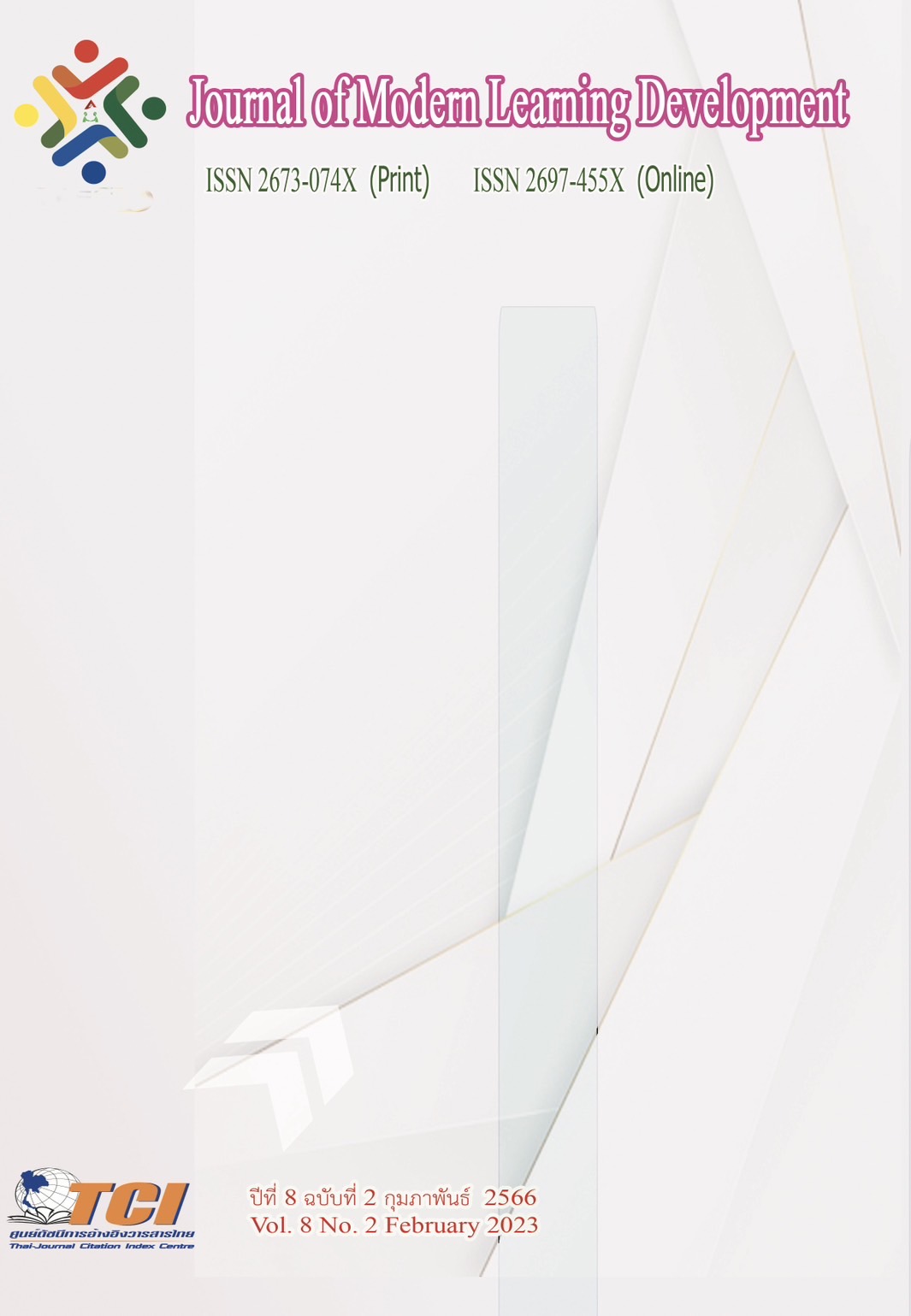The Community Sports and Superstitions
Main Article Content
Abstract
To ideas about ghost worship and rituals for athletes in a community, the notion that intended to enhance the body and mind to produce positive energy. It represents the ideal marriage of sports science and superstition. This academic article, “The Community Sports and Superstitions,” aims to present the superstitions associated with sports within a community concerning the power of spirits and Buddhism. Our findings indicated that a perfect blend of the two science forms, Sports Science and Superstition, was ideal for the strength and good health of athletes, and beliefs about “The power of spirits and Buddhism” being linked to sports in the community helps build morale during sporting events since at times science cannot rely entirely on rationality. Hence, there also exists a belief in superstitions that serves to fill the gaps and build morale during sporting events that correspond to the way of life of the people of the community. Thus, even today, although science and technology have advanced, the community continues to regard the interaction of superstition and science as being perfectly in harmony and not problematic.
Article Details
References
Ballthai. (2020). Sports Superstition. Retrieved from https://www.ballthai.com/scoop/.
Boonchuea. K. (1989). Introduction to theology. Bangkok : Thai Wattana Panich.
Boonsom, N., Pithapornchaikul, K., Bungmark, W., Yanprechaset, T., Kasman, I., and Chantasorn, N. (2017). The Curriculum Evaluation on Bachelor of Science Program inSports Science Faculty of Education, Silpakorn University. Veridian E-Journal, Silpakorn University (Humanities, Social Sciences and arts), 10(1), 786–806. Retrieved from https://he02.tci-thaijo.org/index.php/Veridian-E-Journal/article/view/ 87521/ 69091
Chansem, W. (2015). Sports Science in Sports Development. Academic Journal of Thailand National Sports University, 7(1), 235–239. Retrieved from https://he02.tci-thaijo.org/index.php/TNSUJournal/article/view/256448/174492
Duangkaew, N. (2018). Sports superstition Charm and fun in local sporting events. Retrieved from https://thestandard.co/superstition-sports/
Hongbinbok, W. and Kongsirira, S. (2561). Supernatural Worldviews in Yok Burapa’s Novel: Monkalong. Liberal arts journal Maejo University, 6(2), 111–127. Retrieved from https://so03.tci-thaijo.org/index.php/liberalartsjournal/article/view/161744/116675
Kaewthep, K. et al. (2012). Old media – new media: symbols, identity, ideology. Bangkok: prints.
Kerdkaew, T. (2012). An analytical study of Buddhist symbols that appear in the Thai Yantra. Journal of Buddhist Studies Chulalongkorn University, 19(2), 56–72. Retrieved from https://so02.tci-thaijo.org/index.php/jbscu/article/view/169388
Kerdkaew, T. (2018). A Study of Acronym in 108 Core Scripture as a Supplementary Buddhism Material. Liberal arts journal, 13(26), 51–66. Retrieved from https://so04.tci-thaijo.org/index.php/larhcu/article/view/156501
Khamdee, T. (1991). Superstition and Thai people. Suthiparithat Journal. 5(14), 110–116. Retrieved from https://so05.tci-thaijo.org/index.php/DPUSuthiparithatJournal/ article/view/244742
Khamkhaew. W. (2007). Is superstition really reliant on people in Thai society?. Manutsat Paritat: Journal of Humanities, 29(1), 21-32. Retrieved from https://ejournals.swu.ac. th/index.php/hm/article/view/603
Khunarak, K. (2021). “Amnat Phee Baramee Phut: Space of Religious Ideological Beliefs’ in Tri Aphirum’s romantic novel ‘Miti Thi Sarm”. The Journal of Graduate Saket Review, 6(2), 118–130. Retrieved from https://so03.tcithaijo.org/index.php/saketreview/ article/view/255001
Khunsri, J., Tangpathomwong, N., and Chumpradit, K. (2018). Buddhism Communication through Dhammacakka: Timing, Meaning and Value. Journal of Communication, 1(2), 68–88. Retrieved from https://so01.tci-thaijo.org/index.php/CRRUJC/article/ view/165584
Matichon Company Limited. (2021). The legend of Ai Khai at Wat Chedi. Retrieved from https://www.silpa-mag.com/news/article_63032
Matichon Online. (2020). The phenomenon of “Ai Khai”, the belief of the community. Retrieved from https://www.matichon.co.th/region/news_2347034
Naewna. (2020). A student has a teacher! M.1 student signs a talisman to join the Muay Thai dance, saying 'Powerful, magical'. Retrieved from https://www.naewna.com/likesara/ 522226
Nation Online. (2016). "Rwanda shins" consecrate items at the goalpost before heading in. Retrieved from https://www.nationtv.tv/sport/378529056
Nation Online. (2018). Sports Superstition: From Lester Yantra to Ganesha. Retrieved from https://www.nationtv.tv/news/378666053
Nimnuan, C. (2019). Way of Developing the Competencies for Football Referees in Thai Premierleague to International. Sripatum Chonburi Journal, 15(3), 86-93. Retrieved from https://so05.tci-thaijo.org/index.php/SPUCJ/article/view/189928
Pawalee, P., Tiaotrakul, A., and Jaruchart, T. (2021). Conditions and Guidelines for Athlete Development through Sports Science Principles for the Excellence of the Sports Office in the National Sports University (Northern Campus). Journal of Humanities and Social Sciences Ratchaphruek University, 7(2), 79–95. Retrieved from https://so03.tci-thaijo.org/index.php/rpu/article/view/254776
Phra Atikansurasak Sukhumalo (khongmuang). (2020). Temple with the center of learning and development of the community. Journal of Chaiyaphum Review, 3(1), 37–49. Retrieved from https://so02.tci-thaijo.org/index.php/jcr/article/view/246227
Posttoday. (2016). Taekwondo calls for blessings - receiving talismans. Retrieved from https://www.posttoday.com/sports/445639
Prateepavanich, S. (2015). The development of fashion from the beliefs and amulets of Thailand. Veridian E-Journal, Silpakorn University (Humanities, Social Sciences and arts), 8(5), 59–73. Retrieved from https://he02.tci-thaijo.org/index.php/Veridian-E-Journal/article/view/45418
Pratum, B. (2019). Buddhism: Superstition Ai Khai Wat Chedi with Commodification. Journal of Human Society Nakhon Si Thammarat Rajabhat University. 9(2), 1–18. Retrieved from https://so03.tci-thaijo.org/index.php/humannstru62/article/view/227264
Sihawong, S. (2021). Cultural Diplomacy: Yoga for Health Care in Thailand. Asia Paridarsana, 42(2), 63-81. Retrieved from https://so01.tci-thaijo.org/index.php/ asianreview/article/view/249009
Thairath Online. (2020). Spells and methods of worshiping the egg pagoda temple boy How to pray for blessings. Retrieved from https://www.thairath.co.th/lifestyle/culture/2000361
Treesub, D., Phra Khrusophonkityathorn, Phra Khruphichitsuphakan. (2015). The Buddhist Teachings which are Appeared in The Faith and Magical Ceremony of Khao-Aor School, Phatthalung Province. Journal of MCU Nakhondhat, 2(1), 42–48. Retrieved from https://so03.tci-thaijo.org/index.php/JMND/article/view/152976.


